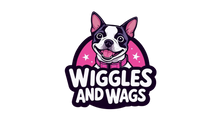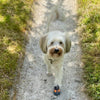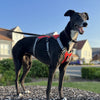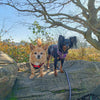How to attach a double ended dog lead to a harness

When we exhibit at UK events, one of the main questions people ask, is "How do I stop my dog from pulling me on walks," followed quickly by "I have tried everything and nothing seems to work."
The fact is that the main reason that many dog pull is down to their desire to get from A-B as quickly as possible. This is absolutely true, but there is a also a fact that owners should open up to - it is you that is letting your dog get away with it!
So if you accept that this is going to be a joint effort, we can begin to look at how much control you really have over your dog. And if the answer is "not a lot" then we need to look at ways to rectify it and to give you back control.
If your dog is pulling ahead and you allow it to do so, it will keep doing it. Your dog quickly understands that if it pulls, you'll follow. You may tug on the lead in an attempt to bring it back and you may also shout an expletive or two when things don't work. Don't get frustrated - just stay calm and be patient.
It is time for you to be the leader of this situation and there are a number of ways you can start to take control.

Most non pull harnesses will have two main clips for a lead - the first one on the dog's chest and the second clip at the top of the dog's back.
If your dog pulls like crazy, you could try a harness, plus double ended lead combo. Basically, this means fitting a suitable harness and then attaching one end of a double-ended training lead to the front clip and the other end to the top clip. This will give you a braking action from the top clip and a steering action from the front clip.
There are certain devices that help you to stay in control and we think that the combination of a double ended dog lead and high quality harness is a very good place to start.
The d ring and o rings (where you attach the lead ends) should also feel robust and well made as a spring lead clip will be attached to these.
It doesn't matter if the harness is padded, but a bit of extra material can be useful for spreading the forces evenly and cushioning any impact on the dog's torso. What is very important though, is how much support the harness gives your dog.
A correctly fitted harness will ensure evenly distributed levels of support around the lower neck, upper chest and rib cage. It is also important that a harness is correctly positioned on the dog and this comes down to correct sizing and style to fit your type of dog.

What you don't want to happen is that the dog's front legs rub heavily on the harness front strap as it walks. You should always make sure that the front straps around the dog's rib cage are at least 3 cms away from the pit of the front legs.
When the harness is fitted and tightened it should be firm and stay in place. When applying backwards force to the top clip and sideways force to the front clip, the harness should not twist and turn or move about excessively.
To take full advantage of the combined attributes of the harness and double ended training lead, you should choose a harness that has these two lead attachment points. The first one will be in the most popular position, which is usually just behind the dog's shoulders. The second fastening should then be located on the front of the harness around the chest.
If you take the strain on the part of the lead attached to the top ring, you will be attempting to stop your dog from pulling you forward. When a resistant force is applied to the front part of the lead, a gentle steering action should occur naturally. This steering direction is determined by which side of the dog you are standing on when walking.
The top attachment is very important because it basically acts as a brake. You will be applying counteracting forces on this part to bring your dog to a halt or to slow it down, just like you would do if you had a standard lead attached to a top ring on a harness - or you were using a traditional collar. However, the front attachment is where it gets a bit more interesting.
You don't need to apply too much force at all - just be gentle and experiment. You want your dog to still enjoy the walk, so don't try to move your dog too violently from left to right. All you need to do is guide/steer your dog lightly or let the lead do the work on its own.
You may also want to reward your dog and reinforce good behaviour when your dogs walks nicely. For example, you could treat your dog when it does this, or if the lead goes slack and it walks closely by your side. This may take some time if your dog pulls like a train, but do persevere.
The lead rings are located down the length of the lead and they are different distances apart from each other. You can use these lead rings in a variety of ways.

By placing one end of the lead through the first ring, you can create a long standard lead. You can then clip the other end of the lead to the first ring to form a handle. As many double ended leads are around 2 metres in length, even part of the lead made up by the handle should give you a lead length of 1.6 metres, which is longer than most standard dog leads.

You can follow the steps described in the long standard lead example above, but this time you can pass one end through the 2nd or third ring instead. This will from a longer loop for a handle and will therefore create a shorter lead.
By using a double ended dog lead and harness you should have more control over your dog and in our experience it really can make a big difference to the enjoyment you and your dog get from the experience.
If you are curious about how this lead could work for you, please take a look at a typical double ended training lead here.
The fact is that the main reason that many dog pull is down to their desire to get from A-B as quickly as possible. This is absolutely true, but there is a also a fact that owners should open up to - it is you that is letting your dog get away with it!
How much control do you have over your dog
So if you accept that this is going to be a joint effort, we can begin to look at how much control you really have over your dog. And if the answer is "not a lot" then we need to look at ways to rectify it and to give you back control.
Be the leader
Before we move onto specific training techniques (and associated aids) we need to look at who is bossing the walk.If your dog is pulling ahead and you allow it to do so, it will keep doing it. Your dog quickly understands that if it pulls, you'll follow. You may tug on the lead in an attempt to bring it back and you may also shout an expletive or two when things don't work. Don't get frustrated - just stay calm and be patient.
It is time for you to be the leader of this situation and there are a number of ways you can start to take control.
Start with the right kit
There are various devices and training aids you can use to help stop the pulling. A good quality no pull dog harness should last you a long, long time and can be an excellent investment. This is a walking device that can be used for many years, but can be a great training aid from day one.
Most non pull harnesses will have two main clips for a lead - the first one on the dog's chest and the second clip at the top of the dog's back.
If your dog pulls like crazy, you could try a harness, plus double ended lead combo. Basically, this means fitting a suitable harness and then attaching one end of a double-ended training lead to the front clip and the other end to the top clip. This will give you a braking action from the top clip and a steering action from the front clip.
There are certain devices that help you to stay in control and we think that the combination of a double ended dog lead and high quality harness is a very good place to start.
Getting a suitable harness
First of all, we cannot emphasise enough the importance of buying a good harness. You'll need one that is made from high quality materials and is well stitched and put together. The main straps should be strong and the buckles firm and fairly tight on the strap material. This will ensure that the harness stands up to a good amount of wear and tear and any size adjustments made will stay in place.The d ring and o rings (where you attach the lead ends) should also feel robust and well made as a spring lead clip will be attached to these.
It doesn't matter if the harness is padded, but a bit of extra material can be useful for spreading the forces evenly and cushioning any impact on the dog's torso. What is very important though, is how much support the harness gives your dog.
A correctly fitted harness will ensure evenly distributed levels of support around the lower neck, upper chest and rib cage. It is also important that a harness is correctly positioned on the dog and this comes down to correct sizing and style to fit your type of dog.

What you don't want to happen is that the dog's front legs rub heavily on the harness front strap as it walks. You should always make sure that the front straps around the dog's rib cage are at least 3 cms away from the pit of the front legs.
When the harness is fitted and tightened it should be firm and stay in place. When applying backwards force to the top clip and sideways force to the front clip, the harness should not twist and turn or move about excessively.
To take full advantage of the combined attributes of the harness and double ended training lead, you should choose a harness that has these two lead attachment points. The first one will be in the most popular position, which is usually just behind the dog's shoulders. The second fastening should then be located on the front of the harness around the chest.
Attaching the double ended lead
When you have attached one end of the double ended training lead to the top ring and the other end to the front ring, you are left with a full loop of lead. This allows you use one or both hands. To use both hands, you can grab part of the lead at the top and part of the lead at the front. You should choose a position on the lead which will give you easy control for when you take the strain. The other way to do it is to hold the end of the loop, which helps to cushion the pulling forces and this can be done with one hand.If you take the strain on the part of the lead attached to the top ring, you will be attempting to stop your dog from pulling you forward. When a resistant force is applied to the front part of the lead, a gentle steering action should occur naturally. This steering direction is determined by which side of the dog you are standing on when walking.
The top attachment is very important because it basically acts as a brake. You will be applying counteracting forces on this part to bring your dog to a halt or to slow it down, just like you would do if you had a standard lead attached to a top ring on a harness - or you were using a traditional collar. However, the front attachment is where it gets a bit more interesting.
The effect of the front clip
When your dog is lightly moved from left to right, it takes your dog away from the pulling action. This can be done with a very light tug on the front part of the lead, if you are using two hands. Alternatively, when the lead goes tight in one hand there should be a very subtle movement to the left or right and this also moves the dog away from pulling forward. Regardless of how you hold and use the double ended dog lead, a force on the front clip takes your dog away from walking forward. The most important thing to note at this point is that your dog is not in control of the walk.You don't need to apply too much force at all - just be gentle and experiment. You want your dog to still enjoy the walk, so don't try to move your dog too violently from left to right. All you need to do is guide/steer your dog lightly or let the lead do the work on its own.
You may also want to reward your dog and reinforce good behaviour when your dogs walks nicely. For example, you could treat your dog when it does this, or if the lead goes slack and it walks closely by your side. This may take some time if your dog pulls like a train, but do persevere.
Change the routine if necessary
Remember that an abundance of smells will stimulate your dog's senses. If the final destination also means fun, games or play then your dog could be pulling to get you there quicker. If this sounds familiar, why not forget about the play every second or third time so your dog doesn't always expect it in the same place on every walk. You might also want to vary the routes and the length of time you are out on walks.Other uses of a double ended dog lead
There are many others ways to use your double clip dog lead and the variations shall depend on which lead rings you use.The lead rings are located down the length of the lead and they are different distances apart from each other. You can use these lead rings in a variety of ways.
As a long standard lead

By placing one end of the lead through the first ring, you can create a long standard lead. You can then clip the other end of the lead to the first ring to form a handle. As many double ended leads are around 2 metres in length, even part of the lead made up by the handle should give you a lead length of 1.6 metres, which is longer than most standard dog leads.
As a lead to walk two dogs
One end will pass through a suitable ring to form a handle and a lead at the desired length. Both ends are now free to attach to twp different dogs and you can use the loop end as a handle.As a shorter standard lead

You can follow the steps described in the long standard lead example above, but this time you can pass one end through the 2nd or third ring instead. This will from a longer loop for a handle and will therefore create a shorter lead.
Used to tether your dog
If you ever need to secure your dog to a stable object, the lead can be used as a useful tethering device. You can pass one end through a clip and use what is left as a handle to secure your dog. The alternative is to wrap one end around an object several times and then clip that end to a ring to secure it.As a short traffic lead
A traffic lead is a basic term given to a lead that is short and strong. If you pass one one end of the lead through 2 or 3 rings you have a strong double lead which is quite short. This keeps the dog close to you if there is a lot of traffic or noise when you walk.As a hands free dog lead
By putting one end through a lower ring, you form a larger loop. This loop can wrap around your waist or shoulders and you can use the lead that way.By using a double ended dog lead and harness you should have more control over your dog and in our experience it really can make a big difference to the enjoyment you and your dog get from the experience.
If you are curious about how this lead could work for you, please take a look at a typical double ended training lead here.
-
Posted in
attaching a double ended dog lead to a harness, double ended dog lead, stop dog pulling on lead






Article is informative. Every thing describe perfect. Whole article is great and pictures are colorful.